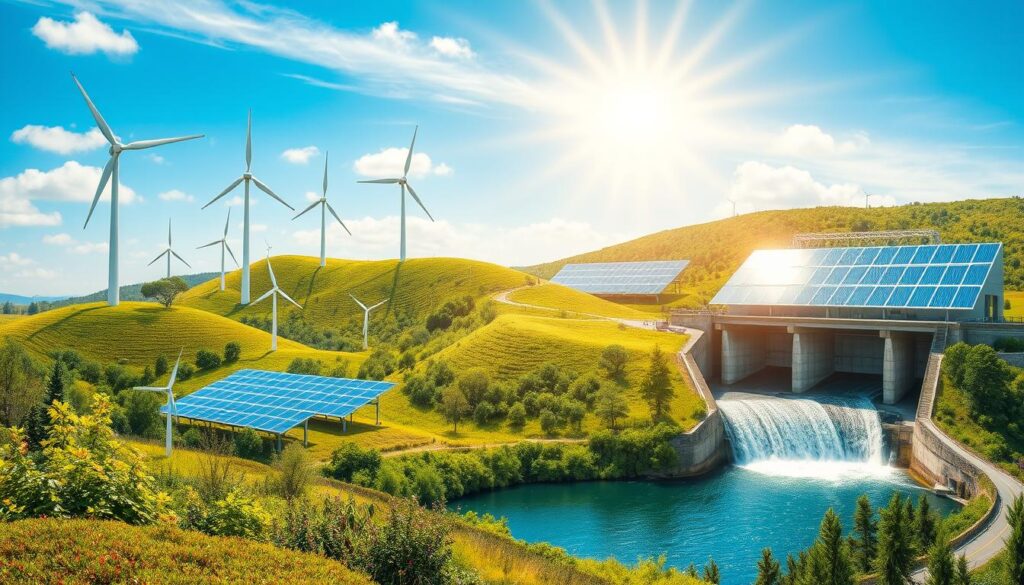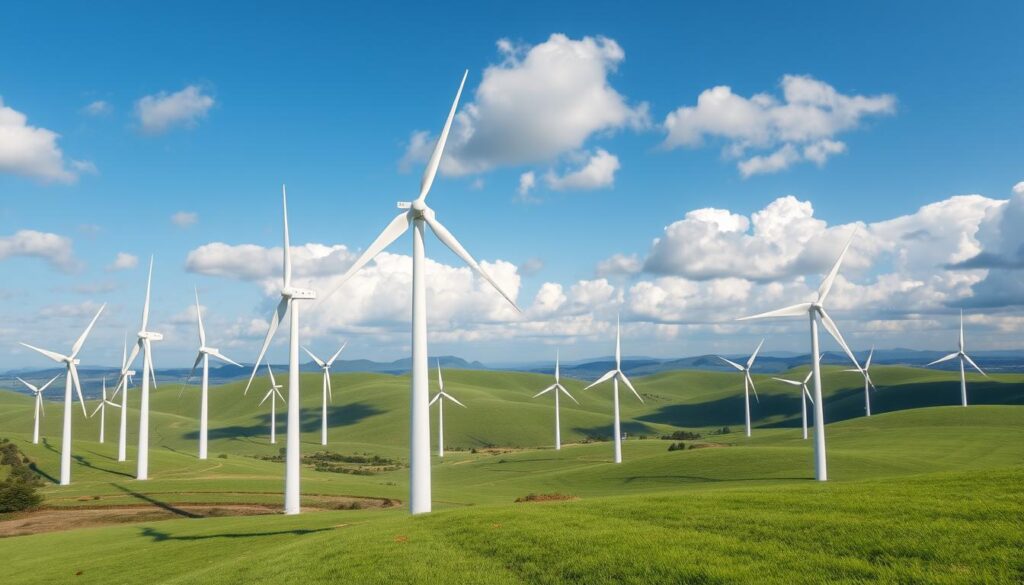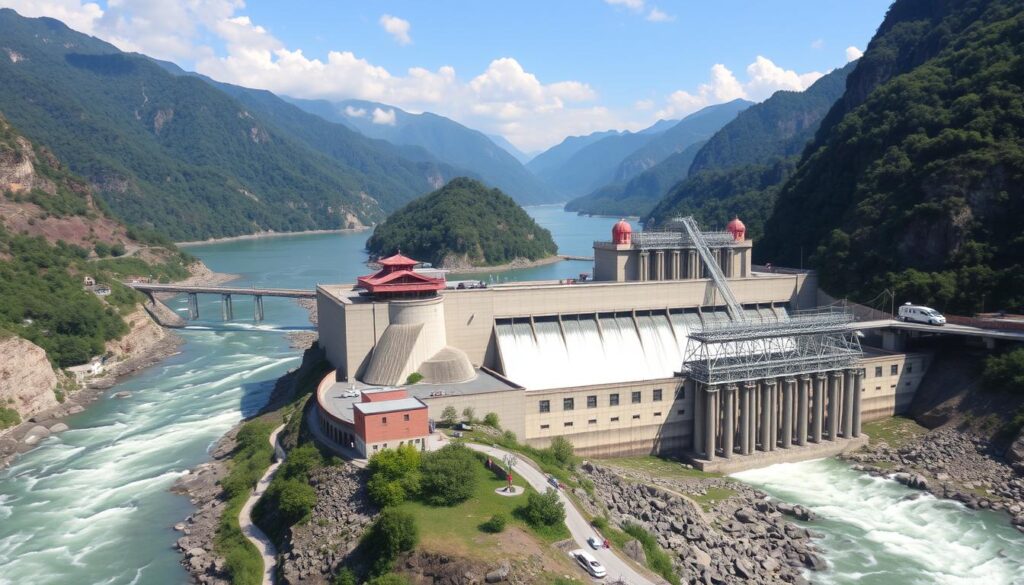The world is facing big challenges with climate change. We need to switch to sustainable energy fast. Renewable energy is key in the fight against global warming. It helps cut down carbon emissions and lessen climate change’s harm.
This article looks at how renewable energy and climate change are connected. We’ll explore the growth of clean power and its role in a greener future.

Key Takeaways
- Renewable energy technologies play a vital role in combating climate change by reducing carbon emissions and promoting sustainable development.
- Innovations in solar, wind, hydroelectric, and geothermal power are driving the clean energy revolution and offering viable alternatives to fossil fuels.
- Transitioning to renewable energy sources is crucial to mitigate the devastating impacts of global warming and protect the planet’s fragile ecosystems.
- Overcoming implementation challenges and promoting widespread adoption of renewable energy is essential to achieve ambitious climate goals and build a more sustainable future.
- The economic benefits of renewable energy, including job creation and cost savings, further strengthen the case for a green energy transition.
Understanding the Global Climate Crisis
The world is facing a critical climate crisis. Alarming trends need our immediate attention. Rising greenhouse gas emissions, sea level rise, and extreme weather events threaten our planet.
Key Climate Change Indicators
Climate change indicators are clear. Global temperatures have been rising, with the last decade being the hottest. Sea levels are rising fast, threatening coastal communities.
The frequency and intensity of extreme weather events have also increased. This includes heatwaves, droughts, and hurricanes.
Impact on Global Ecosystems
The impact of climate change on ecosystems is devastating. Biodiversity loss is happening at an unprecedented rate. Many species struggle to adapt to the changing environment.
Fragile habitats, like coral reefs and rainforests, are under immense pressure. This threatens the delicate balance of natural systems.
Current Environmental Challenges
- Mitigating the release of greenhouse gases to slow global warming
- Adapting to sea level rise and its effects on coastal communities
- Preparing for and responding to extreme weather events
- Preserving and restoring biodiversity to maintain ecosystem health
The global climate crisis is a complex challenge. It requires a comprehensive and collaborative response. Governments, businesses, and individuals must work together to address these pressing issues.
Doing so is crucial for the future of our planet and the well-being of all its inhabitants.
Evolution of Renewable Energy Technologies
The world has seen a big change in renewable energy over the years. We’ve moved from early hydroelectric power to new solar, wind, and geothermal energy. This change has made a big difference in how we get clean energy.
Renewable energy has become more efficient and cheaper. Thanks to new tech, solar panels, wind turbines, and more are getting better and more affordable. This makes them easier for homes and businesses to use.
The push for clean energy has grown because of climate change. The world needs sustainable energy more than ever. Governments, companies, and people are working hard to use energy wisely and sustainably. This effort is helping renewable energy grow fast.
| Milestone | Year | Advancement |
|---|---|---|
| First Photovoltaic Cell | 1954 | Developed by Bell Labs, marking the beginning of solar power technology |
| Wind Turbine Prototypes | 1970s | Early experiments with wind power generation, leading to the modern wind turbine designs |
| Geothermal Power Plant | 1960 | The first geothermal power plant was built in Larderello, Italy, demonstrating the potential of geothermal energy |
| Lithium-Ion Batteries | 1991 | Commercialization of lithium-ion batteries, enabling advancements in energy storage solutions |
Looking ahead, new tech in renewable energy and a global push for sustainability will be key. They will help us create a cleaner, more efficient energy future.
Solar Power: Leading the Clean Energy Revolution
Solar power is a key player in the fight against climate change. It’s a clean, sustainable way to meet our energy needs. This technology is leading the charge towards a greener future.
Photovoltaic Technology Advancements
Photovoltaic (PV) technology is at the core of solar power. It has seen huge improvements in recent years. Now, we have more efficient solar panels that turn sunlight into electricity better and more reliably.
There are many types of solar cells available today. From monocrystalline to thin-film, there’s a wide range for homes and businesses to choose from. This makes it easier for everyone to use solar power.
Solar Thermal Systems
Solar thermal systems are also making a big impact. They use the sun’s heat to warm water or air. This reduces our need for fossil fuels for heating.
When combined with smart building designs, solar thermal systems can change how we use energy. They make buildings more energy-efficient and environmentally friendly.
Energy Storage Solutions
Reliable energy storage is key for solar power to become widespread. New battery technologies, like lithium-ion and flow batteries, store solar energy for later use. This makes solar power a steady, reliable source of energy.
| Technology | Efficiency Improvement | Cost Reduction |
|---|---|---|
| Photovoltaic Panels | 25% to 30% | 50% to 70% |
| Solar Thermal Systems | 35% to 40% | 40% to 60% |
| Battery Storage | 20% to 30% | 60% to 80% |
The growth in solar power tech and energy storage is huge. Solar power is now a top choice in the fight against climate change. As we move towards a sustainable future, solar power shows us the power of clean energy.
“The sun, the moon, and the stars would have disappeared long ago…had they happened to be within the reach of predatory human hands.” – Henry Ellis
Wind Energy: Harnessing Nature’s Power
The world needs to cut down greenhouse gas emissions fast. Wind power is a key solution. Wind turbines, both onshore and offshore, turn wind into clean electricity. This helps us move towards a greener future.
Over the last ten years, wind power capacity has grown a lot. Countries like China, the United States, and Germany are leading. Better designs and manufacturing have made wind turbines more efficient and affordable.
Onshore and Offshore Wind Farms
Wind farms are crucial for wind power. Onshore farms use land winds, while offshore farms use ocean winds. This is because ocean winds are stronger and more steady.
- Onshore farms are cheaper to set up and keep running. But, they’re limited by land and local opposition.
- Offshore farms can use stronger winds. But, they need more money and effort to build and maintain.
Unlocking the Potential of Wind Power
Wind energy is becoming more important as we need more renewable electricity. The industry is using new tech and solving problems to grow. This will help us have a cleaner energy future.

“The wind is a free, renewable resource, so harnessing its power is one of the most efficient ways to generate electricity and combat climate change.”
Renewable Energy Technologies and Climate Change
Switching to renewable energy is key in the fight against climate change. These new solutions can cut down carbon emissions a lot. They also offer economic benefits that help grow the economy and create jobs.
Carbon Emission Reduction Potential
Using more solar, wind, and hydroelectric power can really help reduce carbon emissions. These alternatives can replace fossil fuels, helping to fight climate change. They support global efforts to reduce carbon emissions.
Implementation Challenges
Even though renewable energy is good, making the switch is hard. We need better infrastructure, ways to connect the grid, and solutions for storing energy. This is because some renewable sources are not always available.
Economic Benefits
Renewable energy is good for the planet and for the economy. It creates new green jobs, boosting local economies. It also makes energy more secure and less dependent on expensive fossil fuels. This leads to a cleaner future and helps fight climate change.
| Renewable Energy Technology | Carbon Emission Reduction Potential | Economic Benefits |
|---|---|---|
| Solar Power | Significant reduction in emissions from traditional fossil fuel-based electricity generation | Drives job creation in the solar industry, reduces energy costs, and enhances energy security |
| Wind Energy | Substantial decrease in emissions by replacing coal and natural gas-fired power plants | Generates employment opportunities in wind farm construction, operation, and maintenance |
| Hydroelectric Power | Minimal greenhouse gas emissions compared to fossil fuel-based electricity generation | Provides a reliable and cost-effective source of renewable energy, contributing to energy independence |
“The transition to renewable energy is not only an environmental imperative but also an economic opportunity. By embracing these technologies, we can create a more sustainable future while generating new green jobs and strengthening energy security.”
Hydroelectric Power: Traditional and Modern Approaches
Hydroelectric power is a key part of renewable energy, using water to make clean electricity. Traditional big hydropower plants have been important. But, new ways like run-of-river systems and pumped storage are opening up new possibilities.
Older hydropower plants use dams to make artificial lakes. Water flows through turbines to make electricity. These big projects work well but can harm the environment and affect water use.
- Run-of-river systems are better for nature. They use the river’s flow without big dams. This way, they don’t hurt the environment as much.
- Pumped storage hydropower plants store energy by pumping water uphill when it’s not needed. Then, they release it to make electricity when it’s needed most. This helps the grid and works with solar and wind power.
As we face climate change, hydroelectric power is more important than ever. Using both old and new methods, we can use water’s power. This way, we can meet our energy needs without harming the planet.

“Hydropower is a renewable, clean, and reliable energy source that plays a crucial role in the transition to a sustainable energy future.”
Geothermal Energy: Tapping Earth’s Heat
Geothermal energy is heat from the Earth’s crust. It’s a clean and sustainable power source. This technology is becoming more popular worldwide. It’s used for direct use and in advanced power plants.
Direct Use Applications
Geothermal energy is used directly for heating and cooling. Geothermal heat pumps use the Earth’s heat to warm and cool buildings. This reduces the need for fossil fuels and boosts renewable heating.
Geothermal Power Plants
Geothermal energy can also make electricity. Geothermal power plants use the Earth’s geothermal reservoirs to create steam or hot water. This steam turns turbines to make electricity. Enhanced geothermal systems help tap into deeper, less permeable formations.
Environmental Considerations
Geothermal energy is mostly clean and sustainable. But, we must think about its environmental effects. Issues like earthquakes, water use, and chemical releases need careful handling. This ensures geothermal energy is developed responsibly and safely.
| Geothermal Direct Use | Geothermal Power Plants |
|---|---|
| Utilizes the Earth’s subsurface heat for heating and cooling buildings | Generates electricity by harnessing the heat from the Earth’s geothermal reservoirs |
| Employs geothermal heat pumps to efficiently transfer heat | Includes conventional and enhanced geothermal systems |
| Contributes to renewable heating solutions | Requires careful assessment of environmental impacts |
“Geothermal energy is a renewable, baseload energy source that can play a significant role in the clean energy transition.”
Conclusion
Looking back, we see how renewable energy is key to solving the global climate crisis. Solar, wind, hydro, and geothermal power show great promise. They can power our world and cut down on carbon emissions.
The shift to clean energy is crucial for our planet and can boost the economy. It’s a chance to build a fairer, stronger society. By supporting innovation and renewable energy, we can make a big difference.
We must keep researching and working together to use nature’s power. This will help us create a better planet for future generations. The journey ahead is tough, but together, we can achieve a sustainable future.
FAQ
Q: What are the key climate change indicators?
A: Key signs of climate change include rising global temperatures and sea levels. Glaciers and ice sheets are melting. Ocean acidification and extreme weather events are also on the rise.
Q: How do renewable energy technologies help combat climate change?
A: Renewable energy like solar, wind, and geothermal power cuts down greenhouse gas emissions. They offer clean, sustainable energy instead of fossil fuels.
Q: What are some of the advancements in solar power technology?
A: Solar power tech has improved a lot. Photovoltaic cells work better, and concentrated solar power systems have been developed. Energy storage solutions have also been integrated for better reliability.
Q: What is the potential for wind power in the renewable energy mix?
A: Wind power is growing fast, with more wind farms around the world. Both onshore and offshore farms are boosting renewable electricity generation.
Q: How can hydroelectric power contribute to a sustainable energy future?
A: Hydroelectric power is reliable and renewable. It includes large dams and modern run-of-river systems. It also manages water resources sustainably.
Q: What are the benefits of transitioning to renewable energy technologies?
A: Switching to renewable energy has many benefits. It reduces carbon emissions and creates green jobs. It also improves energy security and supports sustainable development.










